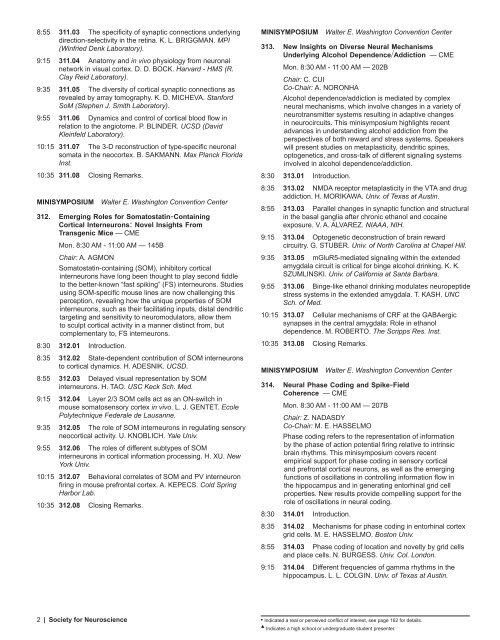nanosymposium - Society for Neuroscience
nanosymposium - Society for Neuroscience
nanosymposium - Society for Neuroscience
Create successful ePaper yourself
Turn your PDF publications into a flip-book with our unique Google optimized e-Paper software.
8:55 311.03 The specificity of synaptic connections underlying<br />
direction-selectivity in the retina. K. L. BRIGGMAN. MPI<br />
(Winfried Denk Laboratory).<br />
9:15 311.04 Anatomy and in vivo physiology from neuronal<br />
network in visual cortex. D. D. BOCK. Harvard - HMS (R.<br />
Clay Reid Laboratory).<br />
9:35 311.05 The diversity of cortical synaptic connections as<br />
revealed by array tomography. K. D. MICHEVA. Stan<strong>for</strong>d<br />
SoM (Stephen J. Smith Laboratory).<br />
9:55 311.06 Dynamics and control of cortical blood flow in<br />
relation to the angiotome. P. BLINDER. UCSD (David<br />
Kleinfeld Laboratory).<br />
10:15 311.07 The 3-D reconstruction of type-specific neuronal<br />
somata in the neocortex. B. SAKMANN. Max Planck Florida<br />
Inst.<br />
10:35 311.08 Closing Remarks.<br />
MINISYMPOSIUM Walter E. Washington Convention Center<br />
312. Emerging Roles <strong>for</strong> Somatostatin-Containing<br />
Cortical Interneurons: Novel Insights From<br />
Transgenic Mice — CME<br />
Mon. 8:30 AM - 11:00 AM — 145B<br />
Chair: A. AGMON<br />
Somatostatin-containing (SOM), inhibitory cortical<br />
interneurons have long been thought to play second fiddle<br />
to the better-known “fast spiking” (FS) interneurons. Studies<br />
using SOM-specific mouse lines are now challenging this<br />
perception, revealing how the unique properties of SOM<br />
interneurons, such as their facilitating inputs, distal dendritic<br />
targeting and sensitivity to neuromodulators, allow them<br />
to sculpt cortical activity in a manner distinct from, but<br />
complementary to, FS interneurons.<br />
8:30 312.01 Introduction.<br />
8:35 312.02 State-dependent contribution of SOM interneurons<br />
to cortical dynamics. H. ADESNIK. UCSD.<br />
8:55 312.03 Delayed visual representation by SOM<br />
interneurons. H. TAO. USC Keck Sch. Med.<br />
9:15 312.04 Layer 2/3 SOM cells act as an ON-switch in<br />
mouse somatosensory cortex in vivo. L. J. GENTET. Ecole<br />
Polytechnique Federale de Lausanne.<br />
9:35 312.05 The role of SOM interneurons in regulating sensory<br />
neocortical activity. U. KNOBLICH. Yale Univ.<br />
9:55 312.06 The roles of different subtypes of SOM<br />
interneurons in cortical in<strong>for</strong>mation processing. H. XU. New<br />
York Univ.<br />
10:15 312.07 Behavioral correlates of SOM and PV interneuron<br />
firing in mouse prefrontal cortex. A. KEPECS. Cold Spring<br />
Harbor Lab.<br />
10:35 312.08 Closing Remarks.<br />
MINISYMPOSIUM Walter E. Washington Convention Center<br />
313. New Insights on Diverse Neural Mechanisms<br />
Underlying Alcohol Dependence/Addiction — CME<br />
Mon. 8:30 AM - 11:00 AM — 202B<br />
Chair: C. CUI<br />
Co-Chair: A. NORONHA<br />
Alcohol dependence/addiction is mediated by complex<br />
neural mechanisms, which involve changes in a variety of<br />
neurotransmitter systems resulting in adaptive changes<br />
in neurocircuits. This minisymposium highlights recent<br />
advances in understanding alcohol addiction from the<br />
perspectives of both reward and stress systems. Speakers<br />
will present studies on metaplasticity, dendritic spines,<br />
optogenetics, and cross-talk of different signaling systems<br />
involved in alcohol dependence/addiction.<br />
8:30 313.01 Introduction.<br />
8:35 313.02 NMDA receptor metaplasticity in the VTA and drug<br />
addiction. H. MORIKAWA. Univ. of Texas at Austin.<br />
8:55 313.03 Parallel changes in synaptic function and structural<br />
in the basal ganglia after chronic ethanol and cocaine<br />
exposure. V. A. ALVAREZ. NIAAA, NIH.<br />
9:15 313.04 Optogenetic deconstruction of brain reward<br />
circuitry. G. STUBER. Univ. of North Carolina at Chapel Hill.<br />
9:35 313.05 mGluR5-mediated signaling within the extended<br />
amygdala circuit is critical <strong>for</strong> binge alcohol drinking. K. K.<br />
SZUMLINSKI. Univ. of Cali<strong>for</strong>nia at Santa Barbara.<br />
9:55 313.06 Binge-like ethanol drinking modulates neuropeptide<br />
stress systems in the extended amygdala. T. KASH. UNC<br />
Sch. of Med.<br />
10:15 313.07 Cellular mechanisms of CRF at the GABAergic<br />
synapses in the central amygdala: Role in ethanol<br />
dependence. M. ROBERTO. The Scripps Res. Inst.<br />
10:35 313.08 Closing Remarks.<br />
MINISYMPOSIUM Walter E. Washington Convention Center<br />
314. Neural Phase Coding and Spike-Field<br />
Coherence — CME<br />
Mon. 8:30 AM - 11:00 AM — 207B<br />
Chair: Z. NADASDY<br />
Co-Chair: M. E. HASSELMO<br />
Phase coding refers to the representation of in<strong>for</strong>mation<br />
by the phase of action potential firing relative to intrinsic<br />
brain rhythms. This minisymposium covers recent<br />
empirical support <strong>for</strong> phase coding in sensory cortical<br />
and prefrontal cortical neurons, as well as the emerging<br />
functions of oscillations in controlling in<strong>for</strong>mation flow in<br />
the hippocampus and in generating entorhinal grid cell<br />
properties. New results provide compelling support <strong>for</strong> the<br />
role of oscillations in neural coding.<br />
8:30 314.01 Introduction.<br />
8:35 314.02 Mechanisms <strong>for</strong> phase coding in entorhinal cortex<br />
grid cells. M. E. HASSELMO. Boston Univ.<br />
8:55 314.03 Phase coding of location and novelty by grid cells<br />
and place cells. N. BURGESS. Univ. Col. London.<br />
9:15 314.04 Different frequencies of gamma rhythms in the<br />
hippocampus. L. L. COLGIN. Univ. of Texas at Austin.<br />
2 | <strong>Society</strong> <strong>for</strong> <strong>Neuroscience</strong> • Indicated a real or perceived conflict of interest, see page 162 <strong>for</strong> details.<br />
� Indicates a high school or undergraduate student presenter.











![[Authors]. [Abstract Title]. - Society for Neuroscience](https://img.yumpu.com/8550710/1/190x245/authors-abstract-title-society-for-neuroscience.jpg?quality=85)





